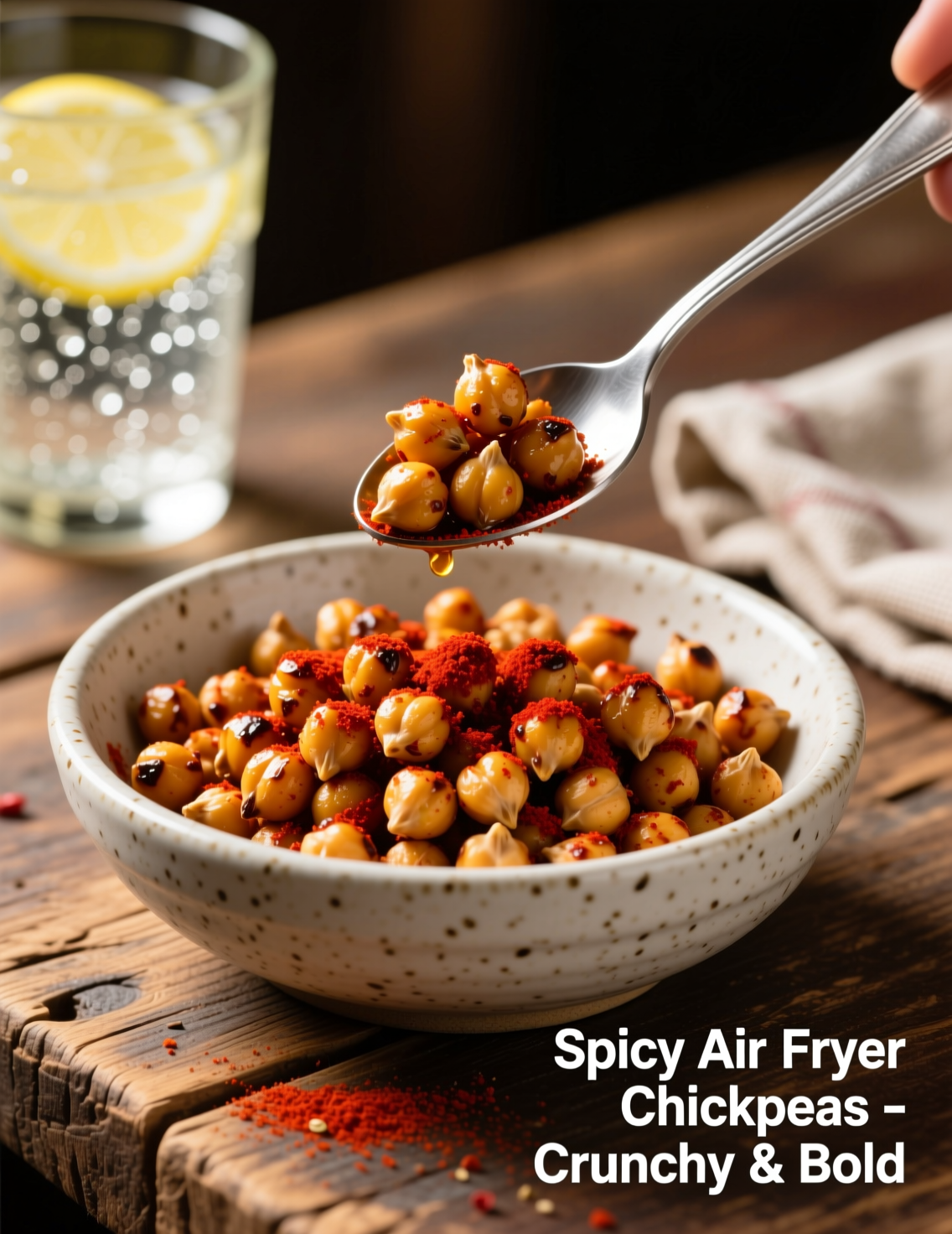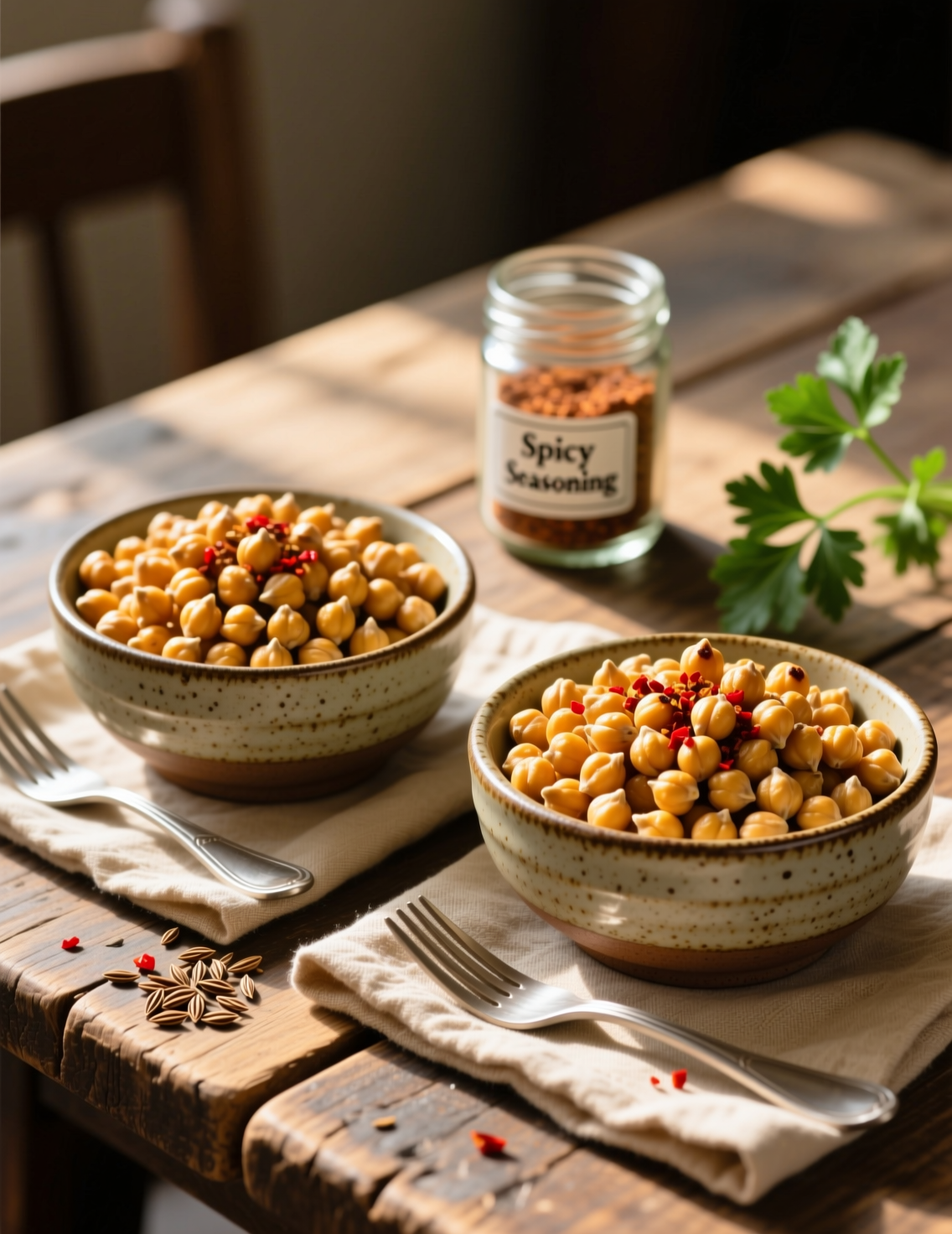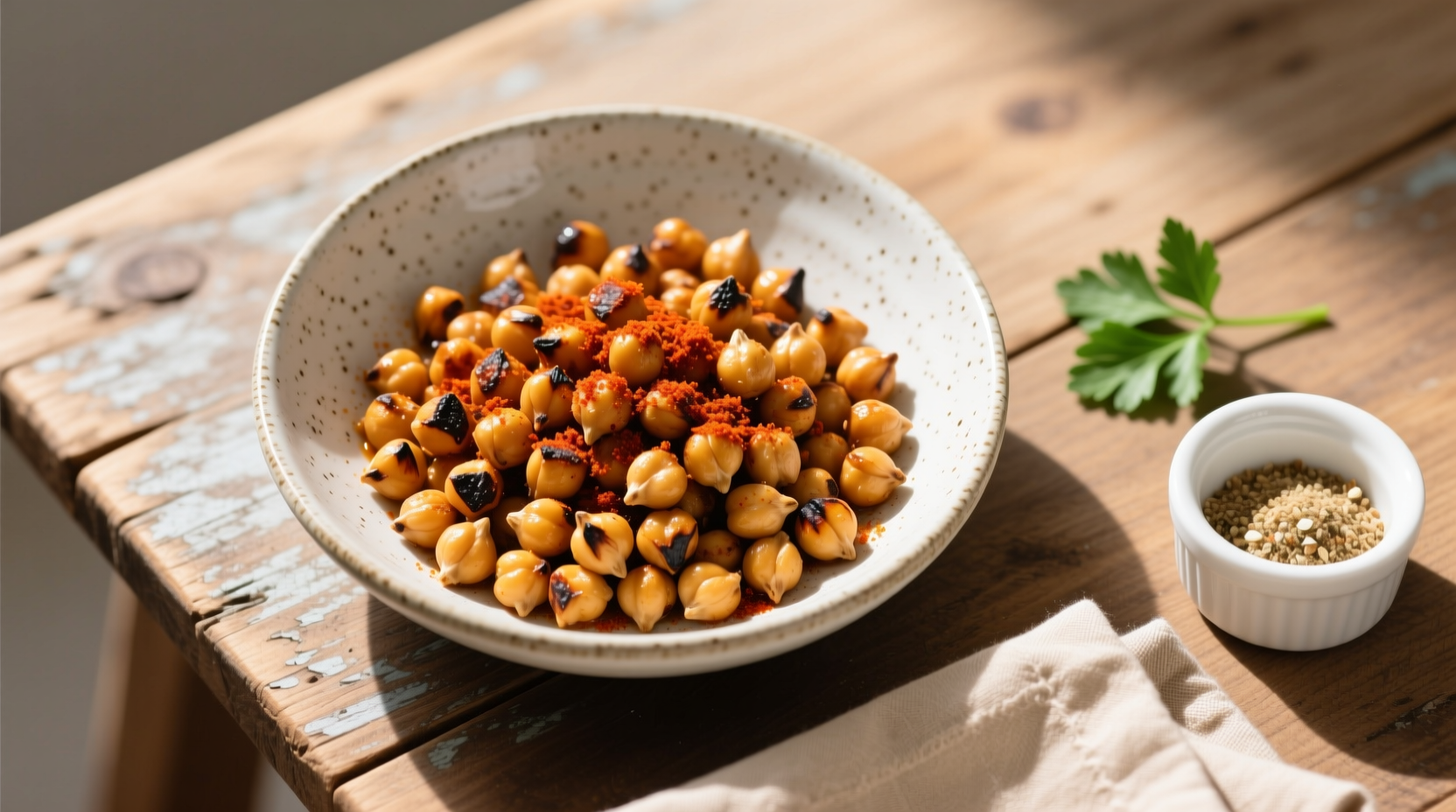Spicy chickpeas from the air fryer sound simple enough, but here’s the secret: they’re more than a quick snack. They’re a masterclass in technique, flavor balance, and the quiet art of speed cooking. When done right, these little legumes go from humble pantry item to crunchy, fiery bites in under 15 minutes. For professionals in kitchens or food developers chasing fast flavor, this dish is proof that precision and minimalism often win.
Why Air Fryer Chickpeas Deserve Serious Attention
You might think of air-fried chickpeas as a trend, but that misses the real story. Chickpeas are one of the oldest cultivated legumes, with records tracing them back 7,500 years in the Middle East. High in protein, fiber, and resistant starch, they’re considered one of the most efficient plant proteins available. The air fryer is simply the modern tool giving them new life.
Data from the USDA shows that one cup of cooked chickpeas has about 14.5 grams of protein and nearly 13 grams of dietary fiber. That’s not just fuel; it’s functionality. In clinical nutrition studies, chickpeas have been linked to reduced LDL cholesterol, improved glycemic control, and satiety that extends beyond other legumes. When chefs and dieticians talk “functional food,” chickpeas walk right into the conversation without even knocking.
Now, consider the air fryer. It circulates hot air at rapid speed around the chickpeas, evaporating surface moisture while crisping the outside. This eliminates the need for deep oil frying while still achieving crunch. Studies on air fryer technology from the Journal of Food Engineering highlight that air-fried products maintain a better nutritional profile, with up to 70% less fat compared to deep-frying. That’s a technical win that doesn’t sacrifice the eating experience.

Ingredients and Ratios Matter
For two servings, the baseline recipe looks straightforward:
- 1 can (15 oz) chickpeas, drained and rinsed thoroughly
- 1 tablespoon olive oil (just enough to coat, no drowning)
- 1 teaspoon smoked paprika
- ½ teaspoon cayenne pepper
- ½ teaspoon garlic powder
- ½ teaspoon onion powder
- ½ teaspoon ground cumin
- ½ teaspoon kosher salt
- Pinch of black pepper
You could double the spices if you want punch-in-the-face heat, but balance is critical. Too much cayenne overpowers the natural nuttiness of the chickpeas. Too little oil, and the spices won’t cling. Too much oil, and instead of crunch, you’ll end up with limp, soggy beans that feel more steamed than roasted.
Professionals know: the coating medium is as important as the spice. Olive oil works for flavor, but if you need higher smoke point stability (industrial kitchens, for instance), avocado oil is safer. Research from the International Journal of Food Science shows that oils rich in monounsaturated fats maintain oxidative stability under air fryer conditions better than polyunsaturated-heavy oils.
Technique Makes the Difference
The steps look easy but small details decide whether your chickpeas sing or sulk.
- Drying matters – After rinsing, lay the chickpeas on a kitchen towel and blot aggressively. Moisture is the enemy of crispness. Even a few drops left on the surface will steam them instead of browning. In Michelin-level kitchens, cooks actually dry them in low ovens for 5–10 minutes before roasting. That’s how seriously professionals treat this step.
- Even oil distribution – Toss the chickpeas with oil before adding the spices. If you add spices first, they clump and burn in patches. Think of oil as primer before painting a wall—it’s what allows color to spread evenly.
- Preheat the air fryer – This step is ignored by home cooks but crucial for consistency. Start at 390°F (200°C). A cold basket drops the initial heat, leading to uneven texture.
- Shake, don’t stir – Every 5 minutes, give the basket a shake. Stirring with a spoon compacts them and sometimes mashes. Shaking keeps airflow even and prevents sticking.
- Timing discipline – 12–15 minutes is the sweet spot. Pull them earlier, they’re chewy. Keep them longer, they’re not just crunchy, they’re teeth-breakers. In professional kitchens, timing is treated like oxygen—you don’t play loose with it.
Beyond the Snack Bowl
Here’s where most people stop: spicy chickpeas in a bowl, eaten by the handful. But professionals don’t think so narrowly.
- Salad topper – Replace croutons with spicy chickpeas. They add crunch, spice, and protein without gluten. A 2023 consumer report noted that 38% of salad consumers now look for “crunchy plant-based add-ins,” making this both trendy and marketable.
- Grain bowls – Add to quinoa, farro, or brown rice bowls for a quick texture contrast. Their spice carries bland bases.
- Soup garnish – Floating chickpeas in creamy soups like carrot-ginger or potato-leek adds crunch where otherwise there’s monotony.
- Bar snack – Spicy chickpeas hold up surprisingly well in bar service settings. They don’t wilt, don’t demand refrigeration, and satisfy the need for salty, spicy finger food. In fact, a pilot test at a London gastro-pub found air-fried chickpeas reduced peanut waste by 40% when offered as an alternative.
Spicing the Right Way
The spice mix isn’t locked in stone. Professionals experiment with global variations.
- Moroccan – Add ground coriander, cinnamon, and a dash of harissa.
- Indian – Use garam masala, turmeric, and chili powder.
- Latin – Smoked paprika, chipotle, and lime zest post-fry.
- Japanese – Shichimi togarashi and sesame oil light drizzle.
Flavor layering is what keeps a simple snack from feeling like a one-note crunch. For high-volume kitchens, offering rotating spice profiles turns one product into multiple menu items without reinventing the wheel.

Addressing Common Mistakes
Too many recipes online skim over the pitfalls. But in practice kitchens, you see them all.
- Not drying properly – we already covered this, but it remains the number one culprit. Chickpeas won’t crisp if wet.
- Overcrowding – An air fryer basket stuffed full suffocates airflow. Better to work in batches.
- Wrong temperature – Lower than 375°F, and you’ll roast endlessly without crunch. Higher than 400°F, and spices scorch before chickpeas crisp.
- Storage mistakes – Freshly fried chickpeas should be cooled completely before storing. If placed warm into containers, trapped steam turns them soggy. Use breathable jars, not airtight plastic, if storing at room temperature.
Nutritional and Market Perspective
From a nutritional lens, these chickpeas are not just indulgence but fuel. For two servings, one batch delivers approximately:
- Calories: ~190 per serving
- Protein: ~7 grams
- Fiber: ~6 grams
- Fat: ~7 grams (mostly unsaturated)
For food brands, spicy chickpeas are part of a rising global trend: crunchy plant proteins as snack alternatives. NielsenIQ reports that plant-based snacks grew 8.6% year-over-year in North America, with “protein-rich legumes” as the fastest expanding subcategory. Air-fried chickpeas fit perfectly in the Venn diagram of health-conscious, convenience, and flavor-packed.
Professionals Talk Texture
Texture is often undervalued by home cooks but it’s everything for chefs. What makes air-fried chickpeas stand out is their duality: a glassy, brittle shell with a nutty, meaty center. This is why they hold up in soups, salads, or even in wraps. If you achieve only crunch without retaining some inner softness, you’ve overshot. If they’re soft all through, you’ve undershot.
Think of it like pasta: al dente chickpeas exist. That’s the goal.
The Recipe in Practice
So here’s the process streamlined, professional-style:
- Rinse and drain 1 can chickpeas.
- Dry thoroughly with towel, optional 5 minutes in low oven.
- Toss with 1 tablespoon oil.
- Add spices evenly.
- Preheat air fryer to 390°F.
- Cook 12–15 minutes, shaking halfway.
- Taste one, adjust salt, and serve immediately or cool before storing.
This yields two servings of crisp, spicy chickpeas ready in under 15 minutes.
The Emerging Trend in Kitchens
Chefs across the US and Europe now treat air-fried chickpeas not as novelty but as a canvas. Restaurants in Brooklyn, Berlin, and Melbourne list them on menus as “crispy chickpeas” or “spiced garbanzo bites.” They’re paired with cocktails, used in vegan protein bowls, or sold in small jars as grab-and-go bar snacks.
This is no passing trend. Consumers demand plant-based, crunchy, portable, and affordable. Chickpeas tick all four boxes.
Conclusion
The 15-minute air fryer spicy chickpeas recipe is deceptively simple but rooted in careful craft. From drying to spice balance to airflow management, small details decide whether the outcome is professional-level or just mediocre. They’re nutritionally sound, versatile across applications, and aligned with modern consumer preferences.
For chefs, they’re a smart way to deliver flavor and crunch without labor-intensive prep. For food developers, they’re a scalable, trendy snack that fits into plant-forward portfolios. For home cooks, they’re a fast bite that feels like restaurant snackware without the bill.
And here’s the final point—sometimes the best recipes aren’t the complicated ones with twenty ingredients. Sometimes it’s just chickpeas, heat, and the discipline to treat them with respect.
FAQs
Can I use dried chickpeas instead of canned?
Yes, but they must be fully cooked and dried before air frying.
Why are my chickpeas not crispy?
They probably weren’t dried well or the basket was overcrowded.
What temperature is best for air frying chickpeas?
390°F (200°C) works best for even crispness without burning spices.
How long do air-fried chickpeas stay crunchy?
They’re best the same day, but last 2–3 days if cooled and stored properly.
Can I reduce the oil in the recipe?
Yes, but too little oil makes spices fall off and chickpeas turn dusty.
Are air-fried chickpeas healthy?
Very—high in fiber, plant protein, and much lower in fat than deep-fried snacks.
Can I change the spice blend?
Absolutely, experiment with Indian, Moroccan, or Latin-inspired seasonings.
Should I preheat the air fryer?
Yes, preheating ensures consistent crunch and prevents soggy centers.
How many servings does this recipe make?
It makes 2 servings, roughly one cup each.
Can I store them in the fridge?
Not ideal—fridge moisture softens them; room temperature in a breathable jar is better.

Mariana is a passionate home cook who creates delicious, easy-to-follow recipes for busy people. From energizing breakfasts to satisfying dinners and indulgent desserts, her dishes are designed to fuel both your body and hustle.
When she’s not in the kitchen, she’s exploring new flavors and dreaming up her next recipe to share with the Foodie Hustle community.

